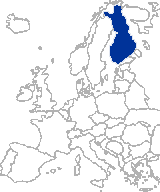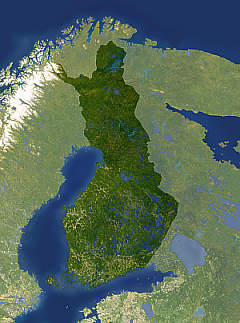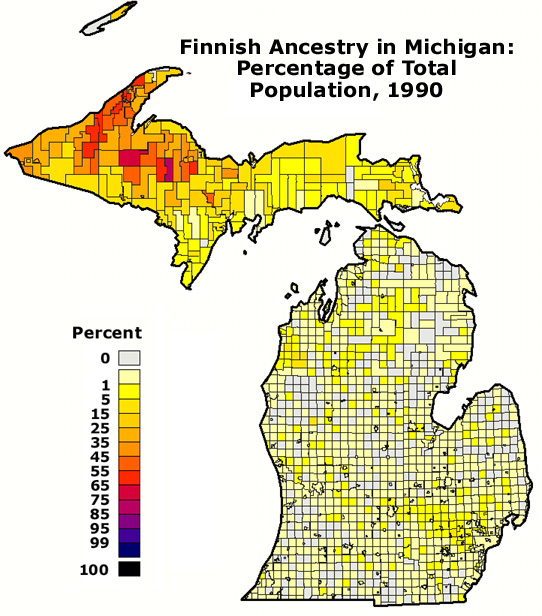WHY ALL THE FINNS IN THE UP? ....one man's opinion
The concentration of Finns of the northern periphery of the Middle West has been a source of commentary by pedestrians as well as scholars. "Environmentalist" assertions hold that the Finns actively sought for, located and settled amidst physical-geographical surroundings that either "resembled Finland," "looked like Finland," "were similar to Finland," or "reminded them of Finland." In the Lake Superior area, and more particularly in northern Michigan, Minnesota, and Wisconsin, they supposedly found this "Finland-like" environment. Hence, the fundamental supposition expressed by the "environmentalists"---that the distribution of Finnish immigrants was geographically induced---has through frequent repetition found general acceptance. Indeed, the myth is embodied in the region’s folklore.
Geographism
Geographism is an explanatory approach to geographical aspects of human
populations. It asserts that geographical attraction---provided by the
physical-geographical environment in toto or by components thereof---is the causal
factor (the independent variable) for determining where people choose to live. If true,
geographism proponents would assert that, given freedom and land, the Finn in the United
States will select an environment that reminds him of the home of his fathers.
Accordingly, Finns selected the Lake Superior area for settlement because it was
"home-like". So strong was the geographic hold on Finns that: "Every
attempt to get away permanently from the Lake Superior region has failed. Thus is may be
stated that, while non-geographic factors have played a part in the settlement of Finns in
northeastern Minnesota, they have been only incidental, and the geographic factors have
been primary." According to geographer Van Cleef, "the most influential"
geographic factors alluring the Finns were: "...the similarity of topography, soil,
and climate in Finland and northeastern Minnesota." as well as in the entire Lake
Superior region.
A Helsinki journalist who visited the United States observed that:
"In general Finns in America have settled in the northern states, where the
environmental conditions have more reminded of homeland than circumstances in other parts
of the country." Another writes that,"...the Finns have always sought those
regions of the United States which most closely resemble Finland." Thus, there is
reason to identify these "resemblances," to establish their existence, and to
ascertain and analyze methods by which proponents of geographism have transformed the
inert "resemblances" into active causal attractors.

Climate?
Some authors declare, without further elaborating, that "climate" attracted
Finns to this region. The majority of authors are of the opinion that aspects of winter,
variously expressed, as "severe winter," "frost," "winter
climate," "snow," "severe temperatures," attracted the Finns,
while others, assert that "invigorating summers," and "seasonal
changes," were what the Finns sought. Regrettably, geographists do not operationally
define--nor do they explain--what constitutes "winter climate" or "severe
temperatures." Neither do they provide an explanation as to when and how is
"summer" sufficiently "invigorating" and "winter" snowy and
severe enough to entice Finns to settle in certain areas.
A comparative study of climatic conditions of the May-through-September
period in Finland and North America reveals that summer climates of Finland have analogues
in parts of Saskatchewan, Alberta, British Columbia, Northwest Territories, and Alaska,
and that year-round climatic conditions "not unlike those of Finland...can be found
in a number of areas in Montana, Idaho, Washington, and Oregon..." and not at all
in the Lake Superior regions."
Vegetation and hydrology?
References to vegetation and hydrographic features are likewise diverse and vague.
"Natural meadows," "deciduous and coniferous trees,"
"berries," "fir," "peat," "spruce, pine, cherry, and
birch woods," and "vegetation," all are said to have attracted the Finns.
With regard to surface water features, "lakes" are the most frequently cited
element of "attraction." One author suggests that "the
inland-sea"--presumably Lake Superior--was important in that it reminded the Finns of
Finland! Curiously, geographists offer no explanation as to what it is about lakes that
supposedly attracted the Finns. Was it open water, or, was it snow and ice cover that
lends a plains-like characteristic to lakes in the Lake Superior area for some four to
five months a year? Others assert that "rivers" reminded the Finns of Finland.

Thus the composite, hypothetical "Finland-like" environment
might be perceived of as a soundless, odorless environment of glaciated terrain; an area
with swamps, soil, boulders, and hills; covered with deciduous and coniferous trees,
berries and peat; having lakes, drained by rivers; a place with climate, snow, frost,
winters, and summer as well. Clearly, the geographical conditions referred to are not
confined to areas where the Finnish immigrants settled. Neither Finland nor the Lake
Superior region have a monopoly on boulders, swamps, birch trees, conifers, rivers, lakes,
and certain types of climate, on their respective continents. Indeed, Finland comprises at
least four basic regions: 1) Coastal Finland; 2) Central Lake Region; 3) Eastern and
Northern Hill Area, and 4) Lappland Tundra region. Finnish geographer Gran�--whose
regionalization of Finland appears in the 1925 edition of the Atlas of Finland--recognizes
19 different geographical provinces, comprising 41 districts and 111 geographical tracts,
in Finland. Therefore, any oversimplification of Finland’s geography, whether it be
expressed simply as "Finland," or as in phrases "reminds of/resembles/is
similar to/looks like/Finland," must be rejected. The "Finland-like"
environment, which purportedly attracted the Finns, must be regarded as mere conjectural
constructs of geographism.
In Baraga County, Finns formed 58.9% and in Ontonagon County 53.6% of
the total foreign-born population. Whatever factors had attracted the Finns there
(according to geographists, attributes of the physical environment, as "swamps,"
"northern climate," "hills," "rocky soils," "cold and
snowy winters,"), must also have been conducive to the Italians, English, Poles,
Swedes, Austrians, French, Germans, Irish, Canadians, and other foreign-born peoples. At
any rate they had to cope with the same environment as did the Finns.

Most of the Finnish emigrants came from the plains of Coastal Finland, especially in
southern Ostrobothnia, where extensive areas are void of lakes and of rocky soils, and
where ecological problems associated with sporadic summer frosts with harvest seasons that
tend to receive excess amounts of rain, with annual spring flooding, and with poor
drainage of fields on clay soils, are paramount. Indeed, it is most puzzling as to how
familiarity with such ecological concerns-or for that matter with the geographist created
"attractors"-explains the fact that by far the majority of the Finns in the Lake
Superior region located in towns and were employed in copper and iron mines. It is
likewise difficult to conceive how laboring 10 to 12 hours a day six days per week in
underground mines (or even in open-pit mines) would "look like" or
"remind" anyone of Finland or of any of the geographical regions of Finland!
Thus, there is no evidence to support the implication advanced by
geographists that arriving Finns possessed or had at their disposal detailed geographical
knowledge about the United States, or, that once in America, they immediately embarked on
fact collecting field trips so that they could discover and settle areas that would remind
them "of the land of their fathers." They came to the UP for work! Work in
the mines.
Modified from a 1971 article by Matti Kaups, in the Papers of the Michigan Academy of Science, Arts, and Letters.
This material has been compiled for educational use only, and may not be reproduced without permission. One copy may be printed for personal use. Please contact Randall Schaetzl (soils@msu.edu) for more information or permissions.